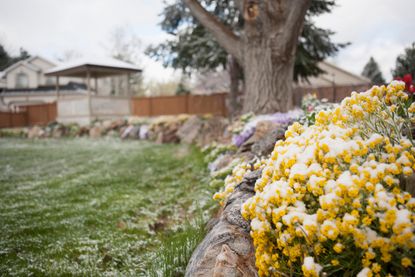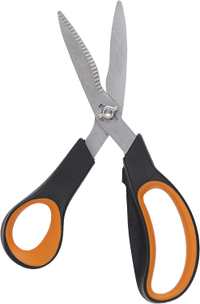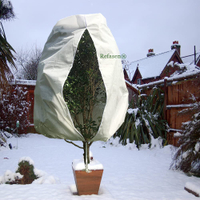Should I cut back plants after a freeze? The gardening rule for the winter months that might surprise you
While freezing temperatures may leave you garden plants looking a mess, there's something you need to know before heading out with the shears


When the temperature outside plunges below freezing, certain plants in your garden can suffer. In my own garden, there have been a few casualties already this year, leaving unattractive dead foliage in pots and raised beds thanks to sub-zero temperatures.
The question is, is it wise to cut back these plants after a freeze? It can be tempting to head out and remove anything that's perished in the cold, but according to horticulture experts, that might not be the best idea for the general health of your modern garden.
I asked those in the know when the best time is to tackle cutting back plants after a freeze, here's what they had to say.

Hugh is Livingetc.com's deputy editor and an experienced homes journalist. Concerned with his own garden suffering in cold temperatures, he asked some horticulture experts for their top advice for plant maintenance after a freeze.
Should you cut back plants after a freeze?
So, do I need to cut back the frost-damaged plants in my backyard?
'Most plants do not need to be cut back after the first freeze in the fall or winter,' explains expert gardener Mary Jane Duford, founder of Home for the Harvest. And, as it turns out, it may be helpful to the plant. 'Leaving them standing can provide habitat for beneficial insects and some winter interest in the landscape,' Mary adds, 'plus spent foliage may also insulate the crown of the plant from fluctuating temperatures.'
However, dead branches and leaves may not be how you want your garden to look all winter long, despite their insulating qualities. In which case, you may need to prune.
For some plants, cutting back is more appropriate than others. 'Certain herbaceous perennials are generally cut back in the fall after the first freeze,' Mary explains. 'This includes hostas, peonies, sedum, Shasta daisy, daylily, and hardy hibiscus. These lovely long-lived flowers tend to be quite hardy and can survive in all but the coldest zones without their spent foliage as insulation.'
With these plants, a frost can cause the leaves to die, which then turn floppy and slimy, while also attracting garden pests like slugs.
How to cut back plants after a freeze
To prevent damage to plants, you need to be careful when pruning back after a freeze. 'Before doing any pruning, carefully examine your plant or tree to determine which parts are dead and which are still alive,' suggests Nastya Vasylchyshyna, a resident botanist expert for the NatureID app. 'Use sharp tools and don’t forget to disinfect them (with rubbing alcohol or a potassium permanganate solution, for example).' Be sure to disinfect tools between pruning different plants, too, as this can help to prevent the spread of diseases between plants.
After a freeze isn't the best time to heavily prune back plants in your flower garden. 'Prune only what is necessary for healthy growth,' says Violet Joy Miller, gardener and founder of Greeny Thumbs. 'Remember that during times of stress (such as after a freeze), trees are more susceptible to disease and pests, so take care not to over-prune.' Nastya suggests cutting into healthy tissue by about 0.4" so that no dead or damaged parts remain.
Stacie from Patio Productions suggests a gentle thinning out of dense plants at this time. 'It encourages air circulation and encourages new growth,' she explains

Garden scissor shears, Fiskars
A pair of good quality garden scissor shears is a must for taking on this task precisely, without damaging the healthy parts of the plant. I find scissor shears a really practical choice, and Fiskars is my go-to brand for garden tools.
When's the best time to prune after a freeze?
It's important not to cut back plants too quickly or else you'll risk damaging them. 'Pruning while the plants are still cold and wet can increase the risk of infection or further damage,' says Stacie Krljanovic, a head groundkeeper and advisor for Patio Productions. 'Wait until the threat of frost has passed and the weather has warmed up before pruning. '
If you're container gardening and plants in pots are damaged, you have more options. 'Either wait till spring or, for potted plants, do it indoors,' says Nastya.

Plant freeze covers, Amazon
If you have any trees that you're particularly worried about when a freeze is incoming, having some of these covers to hand can be an easy way to fend off the worst effects of sub zero temperatures.
Be The First To Know
The Livingetc newsletter is your shortcut to the now and the next in home design. Subscribe today to receive a stunning free 200-page book of the best homes from around the world.

Hugh is the Editor of Livingetc.com. From working on a number of home, design and property publications and websites, including Grand Designs, ICON and specialist kitchen and bathroom magazines, Hugh has developed a passion for modern architecture, impactful interiors and green homes. Whether moonlighting as an interior decorator for private clients or renovating the Victorian terrace in Essex where he lives (DIYing as much of the work as possible), you’ll find that Hugh has an overarching fondness for luxurious minimalism, abstract shapes and all things beige. He’s just finished a kitchen and garden renovation, and has eyes set on a bathroom makeover for 2024.
-
 The 12 Very Best Silk Bedding Pieces — As Our Style Editor Says: 'It's What Dreams Are Made Of!'
The 12 Very Best Silk Bedding Pieces — As Our Style Editor Says: 'It's What Dreams Are Made Of!'Slumber in lustrous luxury with the very best silk bedding sheets, duvets, pillowcases, and more — your sleep score will thank us later
By Julia Demer Published
-
 The 12 Best Wayfair Table Lamps Are All Under $200 — And Our Style Editor Wants The Lot
The 12 Best Wayfair Table Lamps Are All Under $200 — And Our Style Editor Wants The LotThese 12 best Wayfair table lamps are the perfect excuse to get a head start on your President's Day sale shopping. With discounts up to 78% off
By Julia Demer Published

